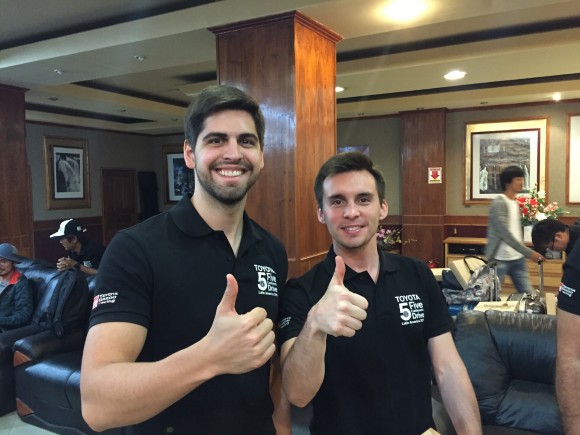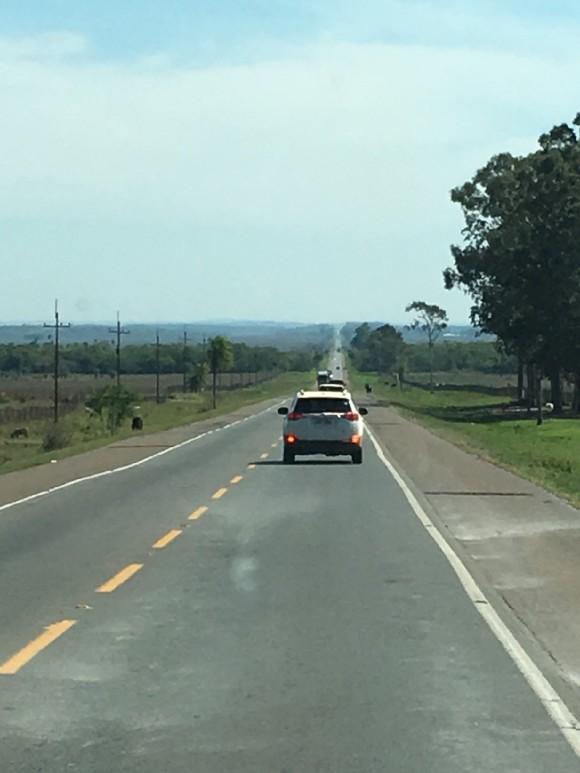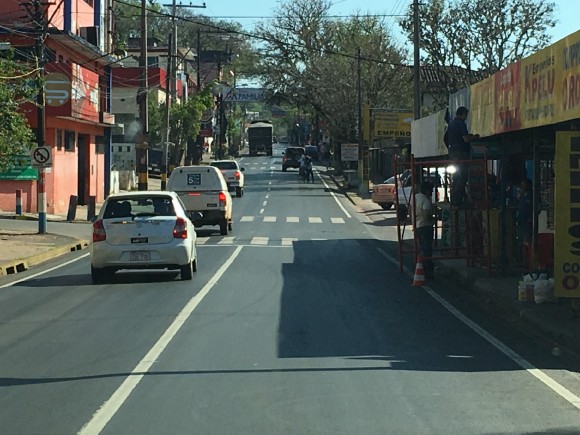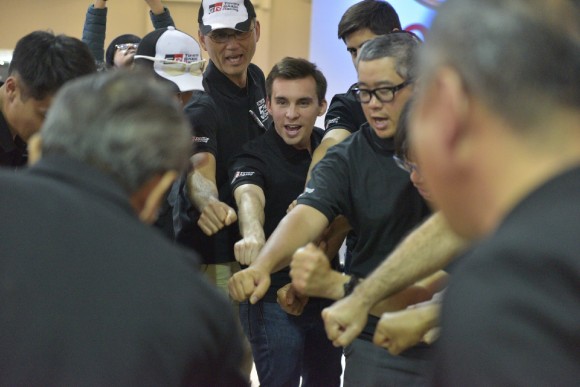The technology to drive across wild lands.
A project started in 1990 to protect the hyacinth macaw, a species of blue parrot listed as endangered. The project conducts field research on the macaw’s ecosystem in the Pantanal and sets up nesting boxes there, a region home to a great many species of wildlife. The project uses Hilux trucks to drive across the prairieland, which becomes inundated with water during the rainy season. Neiva Guedes, the biologist who started the project as a student, offered to show our team some actual nesting boxes. We went deeper into the land, off the roads that take safari tours around and onto roads with barely any tire ruts. The Hiluxes splashed through wet patches on the roads, spraying mud as they went. According to Guedes, the project has been giving feedback since the 1990s on how the Hilux runs in this exceptional environment. We were headed back to our hotel after checking on three nesting boxes when our LC 200 got stuck in front of a gate erected to keep animals from escaping.
The truck that was in front of us slowed down before going over the gate. With too little distance between our vehicles, we were forced to stop in some mud and ended up getting stuck in it. The LC 200 is a heavy vehicle. We first tried to pull it out of the mud using the Hilux’s winch, but the cable immediately snapped in two. The TDB members on our team and the local safari tour guides with us all got down in the mud to try and free us. A local guide had the idea of tying the LC 200 to two Hiluxes with rope and having them pull it out, but even that didn’t work. In the end, we managed to free the LC 200 by shoveling the mud and getting a tractor to pull us. Sasaki from the Production Engineering Development Division, who had been driving, chastised himself for his lack of driving experience, but also looked at getting stuck in a positive light, calling what was basically his first time off-road driving “a very good experience.”
South America Drive Project to experience firsts.
Team leader Matsuo, from the Vehicle Technology Development Division, talks about the intent behind having people with different levels of experience on the drive.
“For some people, it’s their first time driving in a caravan, and for others it’s their first time driving on dirt. If he had maintained more distance in front of the LC 200 and kept driving, he might not have gotten stuck. But getting stuck isn’t a problem at all. On the contrary, it’s an experience that we should welcome. That’s why we have people on our team with more experience—to lend their support at these times.”
We fell behind our day’s schedule getting the LC 200 out of the mud and had to drive on dirt after the sun had set. Clouds of dust billowed up around us, and we could barely see the road surface in the dark with no streetlights. Even Matsuo and the other experienced team members had to concentrate on driving in these conditions.
Speaking of experience levels, Hattori from Legal Affairs may have less experience than the others, but he still showed initiative and took on this project. Even when the LC 200 got stuck, he got down in the mud and appreciated being able to have this car experience.
“I don’t normally come into contact with cars in my work, so I could easily lose sight of what kind of company I work for. I’m an employee of Toyota, and the essence of our work is to ‘make better cars and deliver them to customers.’ I’m participating in the Drive Project to reaffirm this essence of my work and not lose sight of it.”
Meeting customers face to face.
The paved roads got even worse when we left Mato Grosso State and entered Paraná State. There were giant potholes that jostled us around in ways people in Japan couldn’t imagine. A RAV4 nonconforming in the Brazilian market bounced riders around harshly, while an entry-level Etios Hatchback got very positive feedback from the team members riding in it. It really does take genchi-genbutsu—going and seeing for yourself. Cars that have been designed to fit the land are essential. Benacchio, the TDB leader who is heading the Drive Project, hears the same from customers, who assert the importance of cars being made for the land when they talk to him while getting gas.
“No matter which gas station it is, I have the opportunity to talk directly with lots of customers. I hear many good things at the gas stations, and get some complaints too. Customers always bring up the dust problem. I’m embarrassed that we haven’t been able to satisfy customers on this. We absolutely have to make cars that fit the country.”
And then we reached our goal of Paraguay.
Argentina is located on the other side of Iguazu Falls. The caravan went forward, braving the fierce wind that Team 3 was experiencing on their drive on the other side. The journey in Brazil, spanning almost a month, was finished, and the team crossed the border into Paraguay. There was an obvious difference in the cars on the road once we crossed the border over the land route. Except for the Hilux, we didn’t find many Toyotas on the road in Brazil, but there were a lot more Toyotas in the used-car paradise of Paraguay. The TMC members became much more animated upon seeing this. Driving around the border town of Ciudad del Este together with a driver from Toyotoshi, the distributor in Paraguay, we encountered dirt roads similar to those in Sinop, and cobblestone streets similar to those in Teresina, both in Brazil. While similar, Paraguay’s farm roads are narrower with worn ruts, making steering a challenge. And although the cobblestone was relatively well maintained, because of this people also drove on it at high speeds. The cobblestone continued for a long time as well.
We were warmly welcomed the next day at Toyotoshi in the capital city of Asunción. The team members hugged each other and traded compliments on their hard work as they again affirmed that they were the world representatives of Toyota. Then the Drive Project members returned to their own countries, taking with them the demanding topics and new feelings of friendship gained from driving the roads of South America together over about a month.











